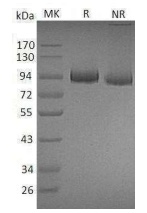FLT1 D5 Recombinant Protein
Shipping Info:
For estimated delivery dates, please contact us at [email protected]
| Amount : | 10 µg |
| Purification : | Greater than 90.0% as determined by(a)Analysis by RP-HPLC.(b)Analysis by SDS-PAGE. |
| Content : | FLT1 D1-5 was lyophilized from a concentrated (1 mg/ml) sterile solution containing no additives. |
| Storage condition : | Lyophilized FLT-1 although stable at room temperature for 3 weeks, should be stored desiccated below -18°C. Upon reconstitution FLT1 should be stored at 4°C between 2-7 days and for future use below -18°C.For long term storage it is recommended to add a carrier protein (0.1% HSA or BSA).Please prevent freeze-thaw cycles. |
| Alternative Name : | FLT-1, FLT1, Tyrosine-protein kinase receptor FLT, Flt-1, Tyrosine-protein kinase FRT, Fms-like tyrosine kinase 1, VEGFR-1. |
It is recommended to reconstitute the lyophilized FLT1 D5 in sterile water not less than 100µg/ml, which can then be further diluted to other aqueous solutions. The activity of FLT1 D5 was determined by its ability to abolish the binding of iodinated VEGF to solid surfaces or cell surfaces. The ED50 for this effect is typically 10 ng/ml, corresponding to a specific activity of 100,000IU/mg. In a 13 day CAM-assay sVEGFR-1 is able to inhibit VEGF stimulated sprouting of capillaries at 30 pM.
For Research Use Only. Not for use in diagnostic/therapeutics procedures.
|
There are currently no product reviews
|














.png)









